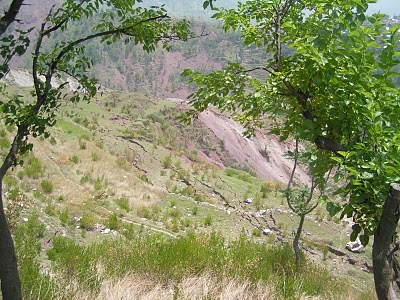20 May 2008
The problem of cracks in mountains after earthquakes
Posted by Dave Petley
Xinhua is today reporting the following:
Nearly 9,000 people in a quake zone were evacuated on Tuesday for fear that huge cracks on a mountain could lead to further disasters. Many crevices, measuring up to 1,500 meters long, 250 m high and 50 centimeters wide, have been spotted on the Shiziliang Mountain in the Qingchuan County seat, Guangyuan City, since Sunday, threatening about 50,000 people and quake-relief soldiers. Part of the mountain, distorted in the 8.0-magnitude earthquake and many aftershocks over the past week, has sunk about 1 meter and caused many road works to cave in. A house at the foot of the mountain was damaged by a falling boulder. Any new aftershock or heavy rainfall in the area could trigger serious landslides and cause casualties, according to the quake relief headquarters at the site. The local government on Tuesday launched an emergency evacuation of 9,000 residents near the mountain. The area has been cordoned off and is under round-the-clock monitoring.
Reading this gave me a very strong sense of deja vu. One of the greatest challenges in Pakistan after the 2005 earthquake was trying to interpret the meaning of similar crack networks, which we found all over the hillsides. The following two images show what these looked like.
 A cracked slope near to Muzaffarabad in Kashmir after the 2005 earthquake (click for a bigger image). Cracked slopes like this occurred throughout the earthquake zone. To date very few have led to a slope failure, but we remain very concerned by them.
A cracked slope near to Muzaffarabad in Kashmir after the 2005 earthquake (click for a bigger image). Cracked slopes like this occurred throughout the earthquake zone. To date very few have led to a slope failure, but we remain very concerned by them. A further cracked slope near to Muzaffarabad in Kashmir after the 2005 earthquake (click for a bigger image). Note that in this case the cracks are very close to a steep cliff. Nonetheless, this slope has still not failed.
A further cracked slope near to Muzaffarabad in Kashmir after the 2005 earthquake (click for a bigger image). Note that in this case the cracks are very close to a steep cliff. Nonetheless, this slope has still not failed.In Pakistan we assumed that these were incipient landslides and worked with the authorities to move people off the worst affected areas before the monsoon. We also put instruments to measure four of the most notable sites. However, this was only an assumption. As it turned out, almost none of these slopes have to date failed. We don’t know why. Are they in fact not landslides at all – if so, what are they? If they are landslides, are they in fact sufficiently stable that they can only move in a large earthquake? Or are they incipient landslides, but they have not failed yet as the rainfall associated with the two monsoons (2006 and 2007) since the earthquake has not been intense in this area (which is the case)? I must admit that I err on the latter, and worry greatly about what will happen in Pakistan in the next really strong monsoon.
In Sichuan, I would be willing to bet that close inspection will reveal that these cracks also occur very extensively across the landscape. Once again the same conundrum will occur. In the case described by Xinhua above the authorities are absolutely right to be cautious, especially if it is actually moving. Evacuation and monitoring appears to be the correct approach. I suspect that this drama will play out in many other places. In Kashmir essentially no resource was dedicated to finding out what these cracks actually meant. I hope very much that this is not repeated in Sichuan.


 Dave Petley is the Vice-Chancellor of the University of Hull in the United Kingdom. His blog provides commentary and analysis of landslide events occurring worldwide, including the landslides themselves, latest research, and conferences and meetings.
Dave Petley is the Vice-Chancellor of the University of Hull in the United Kingdom. His blog provides commentary and analysis of landslide events occurring worldwide, including the landslides themselves, latest research, and conferences and meetings.
According to a Xinhua report on May 22, a 20 member Sichuan province survey team concluded that the mountainside at Beichuan will not collapse and can be stabilized.
Dear David, Do you know the reason why landslide (still) didn't happen on those slopes?Thx